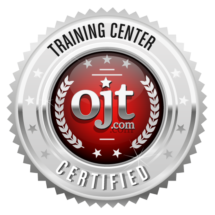
INDUSTRY-LEADING LIVE
INSTRUCTOR-LED TRAINING
World Class Training Content, Delivered On-Demand
BRIDGING THE GAP
between career seekers
& employers
from COAST-TO-COAST

World Class Training Content, Delivered On-Demand
between career seekers
& employers
from COAST-TO-COAST
Welder
QUALIFICATIONS
A high school or General Educational Development (GED) or Welder journeypersons‘ diploma, with or without an Associate Degree, requisite study and practice credit hours, of about 6 months to a year, with certifications like Certified Welder (CW) from an authorized body like the such as the American Welding Society (AWS), or American Society of Mechanical Engineers (ASME) etc.; combined with – On the Job Training (OJT) programs, Apprenticeships, Welder Workforce Job Training or Experience; covering welding and related work topics including reading, understanding & interpreting blueprints and mechanical diagrams & drawings, concepts, principles and types of welding – arc welding, solid state welding and gas welding etc.; welding gases, liquids, metals & their properties, heat treatment and transmission, cutting, brazing, polishing, joints & joints design, melting & welding codes, welding techniques, symbols, processes, standards and best practices; welding equipment maintenance, welding measurements & inspections; finishing, fabrication, controlled experimentation, real-world welding applications; prepping, flaws identification & rectification, apparatus, tools, and equipment, and allied materials, and safety protocols.
AVERAGE HOURLY PAY
(Credits: www.payscale.com)
| Entry-level (0-12 months) | $ 15.71 |
| Early career (1-4 years) | $ 17.26 |
| Mid-career (5-9 years) | $ 19.13 |
| Experienced (10+ years) | $ 20.30 |
PROJECTED GROWTH
(Credits: www.bls.gov)
The welder is a sustainable career, in which employment is expected to grow at an average of 3 percent from 2019 to 2029.
SKILLS/ TRAITS NEEDED
Besides good technical & functional knowledge of welding, processes & techniques, metals, liquids, gases & materials, polishing & finishing, gases & equipment; Welders must have the ability to read, understand and interpret blueprints, mechanical diagrams, and drawings, converting and fabricating them into precision welding joints, fabrications. They must be self-motivated, self-organized with abundant endurance & problem-solving skills, and follow safe work practices with dexterity, extreme focus, great memory, sharp eyesight, quick response, and attention to precision and detail, ensuring timely work completion of their tasks in hand. They also must be professional, ethical, proactive, agile, and alert with a high degree of patience and perseverance; have a great memory, willingness to learn and adapt, listening communication, and interpersonal skills.
WORK FUNCTIONS
Welders, using welding equipment, metals, liquids, gases, flames & welding techniques repair metal structures, tools, and equipment in various domestic and industrial applications. They read, interpret and understand blueprints, mechanical drawings, etc., welding joints, and fabricating with precision & accuracy adhering to the specifications and requirements. Their activities include planning, setting up, prepping, and calibrating the welding equipment; monitoring, testing & delivering welded products to meet the quality assurance and quality control (QA/ QC) standards & production targets ensuring smooth finish of the welded surfaces; preventative welding equipment maintenance keeping them functioning smoothly & safely, maintaining production & material records, ordering materials & supplies, etc. Besides being responsible for trouble-shooting, resolving, or escalating issues they may also be required to train juniors, handle contractors, perform repairs, and keep the work areas clean and organized. Additionally, besides welding, they need to stringently adhere to and follow all safety procedures guidelines issued by Occupational Safety and Health Administration (OSHA). Welders work mostly in the manufacturing and metal fabrication sector. They may be needed to work in shifts.
Related Careers